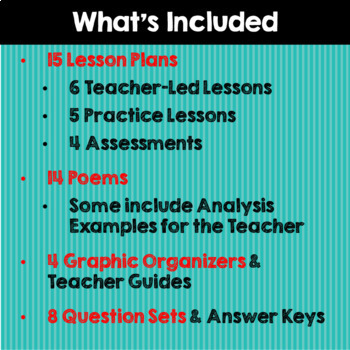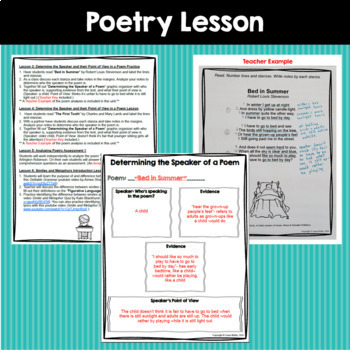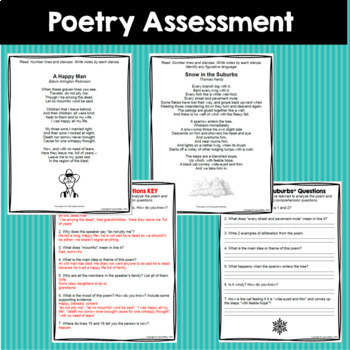Poetry Unit: Analyzing and Comprehending Poems- DIGITAL TOO- 4th, 5th, 6th
- PDF
- Google Apps™

What educators are saying
Description
Overview: In this poetry unit 4th, 5th, and 6th grade students will analyze poems as a class, with a partner, in small groups, and independently. This unit is a great resource for reading comprehension.
DIGITAL COPY AVAILABLE. Link to Google Slides digital copies available when you purchase and download the document. Great for distance and remote learning.
FREE SAMPLE AVAILABLE HERE: Free Sample of Poetry Unit
This poetry unit focuses on:
- Analyzing and labeling the text structure of a poem (lines, stanzas, rhyme pattern, meter, rhythm)
- Determining the theme/main idea of a poem based on textual evidence
- Determining the speaker of a poem and their point of view based on textual evidence
- Identifying similes and metaphors and determining their meanings
- Identifying onomatopoeia and alliteration in poetry
- Making inferences based on text clues and background knowledge
This unit includes:
- 15 Detailed Lesson Plans
- “Poetry Terms” graphic organizer and “Teacher’s Guide”
- “Determining the Theme of a Poem” graphic organizer and "Teacher Guides"
- “Determining the Speaker of a Poem” graphic organizer and "Teacher Guides"
- Youtube Video Links (for figurative language lessons & activities)
- “Figurative Language” graphic organizer and “Teacher’s Guide”
- 14 poems with activities or comprehension questions, including "In Flanders Fields”, "Fog", “Escape at Bedtime”, "The First Tooth", “Bed in Summer”, “A Happy Man”, “Rain”, “Written in March”, “Winter Time”, “Mother to Son”, “Two Old Crows”, “Snow in the Suburbs”, “The Echoing Green”, “The Windmill”
- "Poetry Analysis Examples" for teacher reference
- "Answer Keys" to comprehension questions
** PREVIEW AVAILABLE**
Grades: 4th grade, 5th grade, 6th grade
Common Core: ELA RL.4.1, RL.4.2, RL.4.4, RL.4.5, RL.4.6, RL.4.10, RL.5.1, RL.5.2, RL.5.4, RL.5.5, RL.5.6, RL.5.10, RL.6.1, RL.6.2, RL.6.4, RL.6.5, RL.6.6, RL.6.10
ALSO CHECK OUT:
Poetry Analysis with Similes & Metaphors Task Cards
Poetry Investigation - FREE
Poetry Station/Center- FREE
Inference/Drawing Conclusion Unit
----------------------------------------------------------------------------------------
Be the first to know about my sales and new products:
* Look for the green star next to my photo logo (upper right corner) and click it to become a follower and receive email updates about this store. Thanks!
----------------------------------------------------------------------------------------
Copyright © Laura Heflin, 2020
All rights reserved by author.
Permission to copy for single classroom use only.
Electronic distribution limited to single classroom use only. (Additional licenses available.)
Not for public display.





